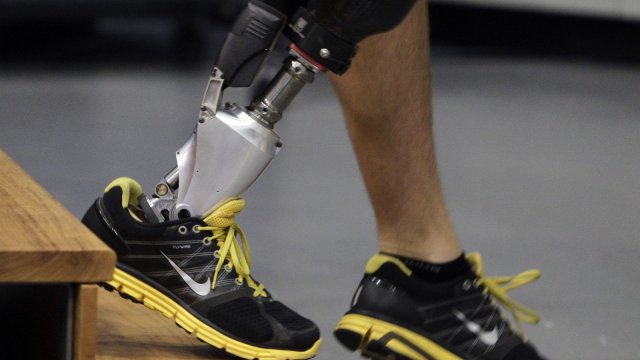The World’s First Bionic Foot Mimics Flexion to Aid Gait (video)
Using traditional lower leg and foot prosthetics is like walking in sand. Since the user can't push off with that foot, there's no muscle for power or an Achilles tendon to pull against. The BiOM prosthetic, however, supplements user effort with robot power.
Even modern carbon fiber prosthetics can require as much as an extra 50 percent effort to move as a natural limb. This makes the wearer walk more slowly and with more effort. "In order to understand what's unique, you have to understand the tech that's been broadly used for the past 25 years," iWalk CEO Tim McCarthy told Forbes. "The existing systems are grossly inefficient, which creates a gait asymmetry because users have to accommodate energy deficiency. This results in a lot of different health problems, such as weight gain and diabetes."
However, the BiOM prosthetic, which Dr. Hugh Herr at MIT's Media Lab licensed to iWalk in 2007, relies on a system known as powered plantar flexion to help propel the user along. PPF uses a series of sensors, motors, and springs to replicate the calf muscles and Achilles tendon, propelling the foot through the step, rather than lugging it along. This makes walking much easier for the wearer—he uses less energy and steps with a more natural gait than could be achieved with an unpowered prosthesis. "What BiOM does is replicate the action of the foot and ankle, Achilles tendon, and lower calf," McCarthy said. "By emulating the bone and soft tissues, it can provide exactly the right amount of energy needed, which makes it as efficient as people with intact limbs. People have told me that it feels like they have their ankle back."
"It felt like a real leg again," Army Sgt. Jourdan Smith, who was wounded in battle, told the Pentagon Report in the video below. "It helps out a lot. It takes strain off my back, my hips...I don't feel as tired at the end of the day." Indeed, the BiOM appears to be a hit among users. The only unit ever returned to the company was done so not because the user didn't like it, but because he didn't use it enough and felt it was wasted on his couch potato lifestyle.
Source: gizmodo





